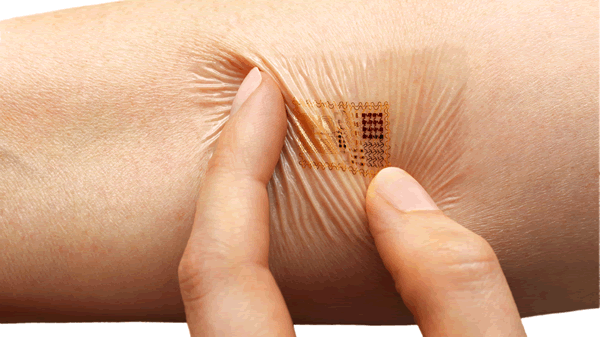Stretchable Electronics are the New Machine-Body Interface
A new class of connectors is poised to enable stretchable electronic devices that will revolutionize patient care.

Sensors have long played a leading role in medicine. They’re employed in every area of patient care, aid in the gathering of data for research, star in applications like patient monitoring, and help medical professionals gather critical data upon which serious diagnosis and treatment decisions are based. Flexible technology has been a key enabling factor in the successful proliferation of sensor equipment, especially within the medical market. The next era of medical monitoring advancements will be based on the flexible capabilities of these present-day sensor technologies. The concept is extending even further with stretchable electronics designed to support sensors that can go anywhere.
Why Stretchable?
Stretchable electronics are one of the key technologies riding the massive sensor wave in the medical field. Designed to provide an adaptable interface between traditionally rigid electronic components and pliable human bodies, these extremely malleable new systems are enabling sensors, integrated circuits, and wireless components to power devices capable of converting biological processes into digital signals and data sources.
The long-term potential of stretchable electronics is enormous. In 2016, Tesla chief Elon Musk founded Neuralink, a company dedicated to the development of a total brain-machine interface. Musk, along with a team of researchers, engineers, biologists, and neuroscientists, plans to develop an implantable device that will effectively treat serious brain injuries. He has recently claimed that such a device could be released to market in as little as four years. At that point, the company plans to shift its focus to further developing the enabling technology behind the treatment device into a “whole brain interface” capable of wirelessly connecting to the cloud. Such devices will inevitably depend upon a complex network of sensors and will be further enhanced by the employment of stretchable microelectronics.
It isn’t just niche medical markets like neurology that are making use of malleable electronics, though. More modest medical devices that utilize stretchable electronics are currently in development and, together, these technologies are building a foundation upon which the next wave of profound advances in healthcare and brain-based communication may very well be built.
The Rogers Research Group
Many of today’s most interesting advances in stretchable electronics trace their origins back to the work of Dr. John Rogers and the Rogers Research Group. Over the past decade, Rogers and his organization, which is associated with Northwestern University, have made significant strides in the development of stretchable and bendable medical devices. Innovations include a device that monitors the electrical activity on the surface of the heart to help surgeons more accurately identify the tissue that needs to be resected to treat cardiac arrhythmias, and another that can similarly interface with the brain to help surgeons treat epilepsy.
Much of this work stems from a 2006 paper in which Rogers describes a flexible silicon substrate that can expand, contract, and bend in ways that cannot be achieved using standard silicon chip material. In 2016, another of Rogers’ organizations partnered with L’Oréal to develop a flexible patch, designed to be sold with sunscreen, that can measure sun exposure and interface with users’ smartphones. This was one of the very first commercial applications of a stretchable, flexible electronic component with a medical use.
Connectors are All-Important to Stretchable Electronics
Interconnects are at the forefront of enabling stretchable electronics, due in large part to their relative simplicity compared to other components. In many devices that utilize stretchable electronics, interconnects are the only components that are fully stretchable, and their presence in a design can imbue the entire device with stretchable properties. This approach is referred to as the rigid island-stretchable interconnect approach, which pairs rigid components like integrated circuits with flexible interconnects to enhance the flexibility of the entire device. Today’s flexible interconnects use thin meandering printed circuit board (PCB) lines to create stretchy connections between rigid components. Although not yet ready for mass production, this technique is already being employed in high-value, low-volume applications such as highly specialized surgical diagnostic tools.
In addition to the rigid island-stretchable interconnect approach, components can be made more malleable by arranging attached wires in such a way that stretching them does nothing to change their length or conductive properties. Another method of introducing flexibility to traditionally rigid circuitry is to employ conductive inks that can be transfer- or screen-printed onto e-textiles.
The Near-Term Market for Medical Stretchables
Printed stretchable electronics based on the use of conductive inks are still an emerging technology. Despite the fact that we have seen significant incremental performance improvements over recent generations of prototypes, the industry has not yet been able to mass-produce conductive-ink-enabled stretchable components capable of consistently meeting performance demands. Companies that currently manufacture conductive, ink-infused e-textiles are getting mixed messages from the market and are fielding requests for products at both ends of the conductivity and stretchability spectrum, which is making standardization challenging.
Although the list of potential medical applications for stretchable electronics spans the gamut from custom- to mass-produced systems, the difficulties currently surrounding stretchable component standardization and mass production will likely mean that highly specialized equipment and custom-designed devices will continue to be among the most fervent adopters for some time still. Products like the L’Oréal sun exposure monitor will continue to become more available to consumers, but until manufacturers can develop more standardized and mass-producible components, custom applications like the Rogers Research Group’s surgical diagnostic devices will continue to drive technical advancement in stretchable electronics. Additionally, until significant technological advancements allow currently rigid components, like transistors and boards, to become more flexible, stretchable connectors will continue to be the critical enabling technology behind the continued development of stretchable electronics.
Recently posted:
[related_posts limit=”10″]






